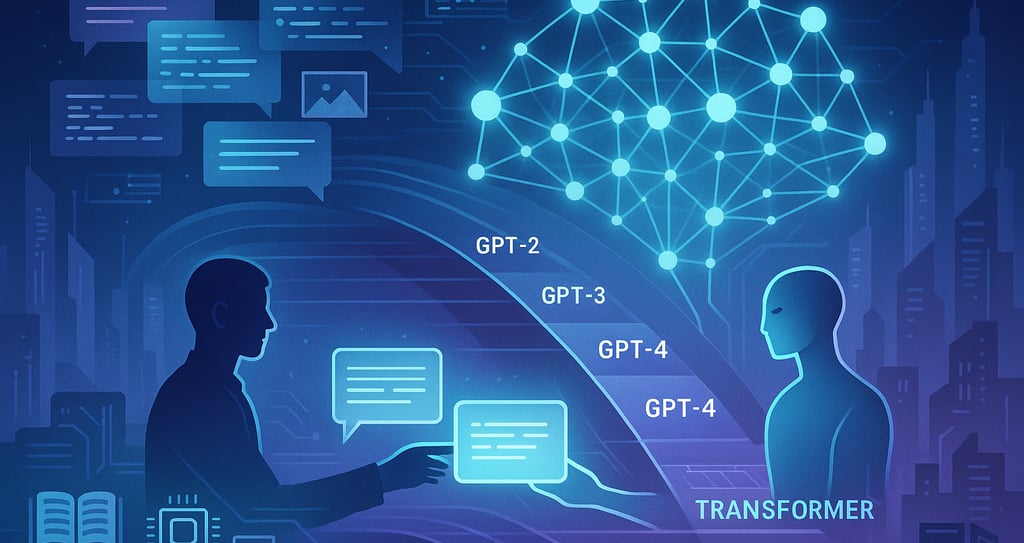Significant Applications and Use Cases of Large Language Models (LLMs) in 2025. Chapter 5:
This chapter explores current and emerging applications of Large Language Models (LLMs) in 2025, highlighting their impact across sectors like customer service, healthcare, legal, finance, and education, and presents practical cases illustrating their technological and social transformation.
8/25/20253 min read


Chapter 5: Significant Applications and Use Cases of Large Language Models (LLMs) in 2025
5.1 Introduction
In 2025, Large Language Models (LLMs) not only represent a major technological advancement but their practical adoption has permeated numerous sectors, transforming the way companies, institutions, and professionals approach the production, interaction, and analysis of information. The diversity of applications has expanded and become more sophisticated, thanks to continuous improvements in training, multimodal capacity, and real-time data integration techniques, as we have seen in previous chapters.
This chapter provides a detailed overview of the main current and emerging applications of LLMs, illustrating with real examples and practical cases their impact in areas such as customer service, content generation, legal, medical, education, finance, and more.
5.2 Conversational Assistants and Intelligent Chatbots
LLMs have completely reinvented human-machine interaction, offering chatbots that not only understand complex queries but respond naturally, contextually, and empathetically.
Customer service chatbots: Leading companies integrate LLMs like GPT-4o or Claude 3 to provide 24/7 support, handle inquiries, resolve multifaceted problems, and escalate critical cases to humans with smooth handoffs. Reduced wait times and improved response accuracy have significantly increased user satisfaction.
Internal communication automation: LLMs summarize and coordinate information across multiple departments, facilitating collaboration processes and knowledge management. For example, synthesizing meeting notes or complex requests to speed up corporate responses. (Forbes)
Multilingual support: Powerful models enable simultaneous support in multiple languages with a high level of detail and coherence, eliminating language barriers and expanding global markets.
5.3 Automatic Generation of Textual Content
Automatic text generation is a field where LLMs excel with capabilities ranging from assisted writing to autonomous document creation.
AI-assisted journalism: LLMs create drafts, summaries, and news analyses based on updated data and facts, accelerating production without sacrificing accuracy when combined with automatic verification systems. (Ehud Reiter)
Marketing and advertising: They generate personalized and creative content for social media campaigns, corporate emails, blog articles, and even product descriptions, optimizing reach and engagement.
Creative writing: Assist writers with ideas, plot structuring, and realistic dialogue generation, pushing the boundaries of literature and entertainment.
5.4 Code Generation and Correction
One of the most relevant technological applications is support in software development.
Auto-coding and debugging: Models like GPT-4o and Qwen can produce code snippets in various languages, optimize algorithms, and find errors with clear explanations, speeding up development cycles.
Programming assistants: Integrated within IDEs, they offer contextual support to complete functions, translate documentation, and explain complex behaviors.
Programming education: They provide personalized tutoring to students and professionals learning to code.
5.5 Automatic Translation and Multilingual Processing
The advanced ability to process multiple languages and dialects is one of the major advances of current LLMs.
Contextualized translation: Beyond simple lexical substitution, models handle cultural contexts, technical terms, and linguistic registers to deliver accurate and natural translations.
Real-time communication: Applications in videoconferencing and chats translate simultaneously with automatic language detection and processing of tone and intonation.
5.6 Paraphrasing, Summarizing, and Rewriting Texts
LLMs facilitate text reformulation to adjust detail level, tone, or target audience.
Document synthesis: They generate executive summaries, extract key ideas, and organize complex information for quick understanding.
Creative rewriting: Adapt text style as required, from formal academic format to colloquial language.
5.7 Industrial and Sector-Specific Applications
5.7.1 Health and Medicine Sector
LLMs are used in:
Diagnostic support: Assist in interpreting medical data, summaries of patient histories, and scientific literature to aid preliminary diagnoses.
Clinical report generation: Automate writing of studies, prescriptions, and patient follow-ups.
Medical education and continuous training: Facilitate professional updates with detailed explanations and conversational simulations.
5.7.2 Legal Sector
Legal analysis: LLMs process large volumes of legal documents, identify precedents, draft contracts, and help prepare cases with high accuracy.
Regulatory compliance: Monitor regulatory changes and generate summaries to facilitate corporate adaptation.
Document automation: Streamline creation and review of legal documents to reduce time and errors. (ACC Docket)
5.7.3 Financial Sector
Financial statement analysis: LLMs carry out detailed and comparative analyses of balance sheets, cash flows, and results for strategic decision-making.
Fraud detection: Identify irregular patterns in transactions and report potential risks.
Automated consulting: Provide investment advice through generation and evaluation of scenarios with real-time data. (Arya.ai)
5.7.4 Education and Training
Personalized tutoring: Adapt content and pace to each student’s profile, answering questions, generating exercises, and providing immediate feedback.
Creation of educational materials: Generate specialized texts, guides, and multimedia resources by discipline.
Automated assessment: Grade open-ended responses and generate reports on student progress and difficulties.
5.8 Emerging Innovative Use Cases
Personalized data visualization: Users can request LLMs to generate real-time interactive visualizations based on complex data, integrating APIs and dynamic analysis. (TinyBird)
Precision agriculture: Models support decision-making for efficient use of resources like water and fertilizers through recommendations based on real-time environmental and commercial data. (Orq.ai)
Autonomous agents: LLMs act as coordinators to manage complex workflows in industrial automation and logistics.
5.9 Conclusion
The range of LLM applications in 2025 reflects exponential and robust advancement that goes beyond simple natural language processing to become versatile tools for support, automation, and knowledge creation. Their adaptation to specific needs, integration with dynamic data, and improvements in security and ethical control ensure that their impact will continue to expand significantly.
